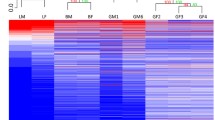Abstract
Seventy-five years after the discovery of the first coelacanth the genome sequence of the Latimeria chalumnae has been completed. The Latimeria genome will be an invaluable resource for inferring evolutionary processes that happened during the transition from water to land. The first analyses of genes and regulatory elements disclosed changes, which permitted vertebrate adaptation to land. A phylogenomic analysis again strongly supports that the lungfishes are the closest living relatives of the tetrapods.
Similar content being viewed by others
Literatur
Smith JLB (1939) A living fish of mesozoic type. Nature 143:455–456
Amemiya CT, Alföldi J, Lee AP et al. (2013) The African coelacanth genome provides insights into tetrapod evolution. Nature 496:311–316
Meyer A, Wilson AC (1990) Origin of tetrapods inferred from their mitochondrial DNA affiliation to lungfish. J Mol Evol 31:359–364
Brinkmann H, Venkatesh B, Brenner S et al. (2004) Nuclear protein-coding genes support lungfish and not the coelacanth as the closest living relatives of land vertebrates. Proc Natl Acad Sci USA 101:4900–4905
Lampert KP, Fricke H, Hissmann K et al. (2012) Population divergence in East African coelacanths. Curr Biol 22:R439–440
Author information
Authors and Affiliations
Corresponding authors
Additional information
Manfred Schartl Jahrgang 1953. 1973–1977 Biologe- und Chemiestudium an der Universität Gießen. 1980 Promotion in Genetik bei Prof. Dr. F. Anders. 1980–1984 Postdoc in Gießen und am National Institutes of Health in Bethesda, MD, USA. 1985–1991 Nachwuchsgruppenleiter am Genzentrum des Max-Planck-Instituts für Biochemie in Martinsried. Seit 1991 Ordinarius für Physiologische Chemie am Biozentrum der Universität Würzburg.
Axel Meyer Jahrgang 1960. 1979–1982 Biologiestudium an den Universitäten Marburg, Kiel und Miami. 1985 Masters Degree in Zoology, University of California in Berkeley. 1986–1987 Studium an der Harvard University. 1988 Promotion an der University of California in Berkeley. 1988–1990 Alfred P. Sloan Postdoc bei Prof. A. C. Wilson, Fachbereich Biochemie in Berkeley. 1990–1997 Assistant und Associate Professor im Department of Ecology and Evolution an der State University of New York, in Stony Brook. Seit 1997 Professor für Zoologie und Evolutionsbiologie an der Universität Konstanz.
Rights and permissions
About this article
Cite this article
Schartl, M., Meyer, A. Die Entschlüsselung des Genoms des Quastenflossers. Biospektrum 19, 515–519 (2013). https://doi.org/10.1007/s12268-013-0349-2
Published:
Issue Date:
DOI: https://doi.org/10.1007/s12268-013-0349-2




